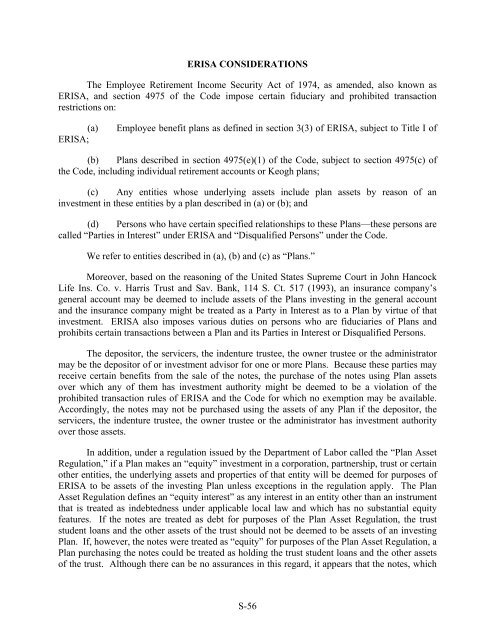LISTING SUPPLEMENT $189000000 Class A-1 Notes $342100000 ...
LISTING SUPPLEMENT $189000000 Class A-1 Notes $342100000 ...
LISTING SUPPLEMENT $189000000 Class A-1 Notes $342100000 ...
Create successful ePaper yourself
Turn your PDF publications into a flip-book with our unique Google optimized e-Paper software.
ERISA CONSIDERATIONS<br />
The Employee Retirement Income Security Act of 1974, as amended, also known as<br />
ERISA, and section 4975 of the Code impose certain fiduciary and prohibited transaction<br />
restrictions on:<br />
(a)<br />
ERISA;<br />
Employee benefit plans as defined in section 3(3) of ERISA, subject to Title I of<br />
(b) Plans described in section 4975(e)(1) of the Code, subject to section 4975(c) of<br />
the Code, including individual retirement accounts or Keogh plans;<br />
(c) Any entities whose underlying assets include plan assets by reason of an<br />
investment in these entities by a plan described in (a) or (b); and<br />
(d) Persons who have certain specified relationships to these Plans—these persons are<br />
called “Parties in Interest” under ERISA and “Disqualified Persons” under the Code.<br />
We refer to entities described in (a), (b) and (c) as “Plans.”<br />
Moreover, based on the reasoning of the United States Supreme Court in John Hancock<br />
Life Ins. Co. v. Harris Trust and Sav. Bank, 114 S. Ct. 517 (1993), an insurance company’s<br />
general account may be deemed to include assets of the Plans investing in the general account<br />
and the insurance company might be treated as a Party in Interest as to a Plan by virtue of that<br />
investment. ERISA also imposes various duties on persons who are fiduciaries of Plans and<br />
prohibits certain transactions between a Plan and its Parties in Interest or Disqualified Persons.<br />
The depositor, the servicers, the indenture trustee, the owner trustee or the administrator<br />
may be the depositor of or investment advisor for one or more Plans. Because these parties may<br />
receive certain benefits from the sale of the notes, the purchase of the notes using Plan assets<br />
over which any of them has investment authority might be deemed to be a violation of the<br />
prohibited transaction rules of ERISA and the Code for which no exemption may be available.<br />
Accordingly, the notes may not be purchased using the assets of any Plan if the depositor, the<br />
servicers, the indenture trustee, the owner trustee or the administrator has investment authority<br />
over those assets.<br />
In addition, under a regulation issued by the Department of Labor called the “Plan Asset<br />
Regulation,” if a Plan makes an “equity” investment in a corporation, partnership, trust or certain<br />
other entities, the underlying assets and properties of that entity will be deemed for purposes of<br />
ERISA to be assets of the investing Plan unless exceptions in the regulation apply. The Plan<br />
Asset Regulation defines an “equity interest” as any interest in an entity other than an instrument<br />
that is treated as indebtedness under applicable local law and which has no substantial equity<br />
features. If the notes are treated as debt for purposes of the Plan Asset Regulation, the trust<br />
student loans and the other assets of the trust should not be deemed to be assets of an investing<br />
Plan. If, however, the notes were treated as “equity” for purposes of the Plan Asset Regulation, a<br />
Plan purchasing the notes could be treated as holding the trust student loans and the other assets<br />
of the trust. Although there can be no assurances in this regard, it appears that the notes, which<br />
S-56
















